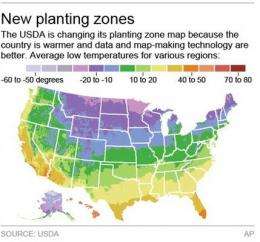New map for what to plant reflects global warming

(AP) -- Global warming is hitting not just home, but garden. The color-coded map of planting zones often seen on the back of seed packets is being updated by the government, illustrating a hotter 21st century.
It's the first time since 1990 that the U.S. Department of Agriculture has revised the official guide for the nation's 80 million gardeners, and much has changed. Nearly entire states, such as Ohio, Nebraska and Texas, are in warmer zones.
The new guide, unveiled Wednesday at the National Arboretum, arrives just as many home gardeners are receiving their seed catalogs and dreaming of lush flower beds in the spring.
It reflects a new reality: The coldest day of the year isn't as cold as it used to be, so some plants and trees that once seemed too vulnerable to cold can now survive farther north.
"People who grow plants are well aware of the fact that temperatures have gotten more mild throughout the year, particularly in the wintertime," said Boston University biology professor Richard Primack. "There's a lot of things you can grow now that you couldn't grow before."
He uses the giant fig tree in his suburban Boston yard as an example: "People don't think of figs as a crop you can grow in the Boston area. You can do it now."
The new guide also uses better weather data and offers more interactive technology. For example, gardeners using the online version can enter their ZIP code and get the exact average coldest temperature.
Also, for the first time, calculations include more detailed factors such as prevailing winds, the presence of nearby bodies of water, the slope of the land, and the way cities are hotter than suburbs and rural areas.
The map carves up the U.S. into 26 zones based on five-degree temperature increments. The old 1990 map mentions 34 U.S. cities in its key. On the 2012 map, 18 of those, including Honolulu, St. Louis, Des Moines, Iowa, St. Paul, Minn., and even Fairbanks, Alaska, are in newer, warmer zones.
For example, Des Moines used to be in zone 5a, meaning the lowest temperature on average was between minus 15 and minus 20 degrees. Now it's 5b, which has a coldest temperature of 10 to 15 degrees below zero.
Those differences matter in deciding what to plant. Griffin, Ga., used to be in zone 7b, where the coldest day would average between 5 and 10 degrees. But the city is now in zone 8a, averaging a coldest day of 10 to 15 degrees. So growing bay laurel becomes possible. It wasn't recommended on the old map.
Mark Kaplan, a New York meteorologist who helped create the 1990 map, said the latest version clearly shows warmer zones migrating north. Other experts agreed.
The 1990 map was based on temperatures from 1974 to 1986, the new map from 1976 to 2005. The nation's average temperature from 1976 to 2005 was two-thirds of a degree higher than it was during the old time period, according to the National Climatic Data Center.
USDA spokeswoman Kim Kaplan, who was part of the map team, repeatedly tried to distance the new zones on the map from global warming. She said that while much of the country is in warmer zones, the map "is simply not a good instrument" to demonstrate climate change because it is based on just the coldest days of the year.
David W. Wolfe, a professor of plant and soil ecology at Cornell University, said that the USDA is being too cautious and that the map plainly reflects warming.
The revised map "gives us a clear picture of the `new normal' and will be an essential tool for gardeners, farmers and natural resource managers as they begin to cope with rapid climate change," Wolfe said in an email.
The Arbor Day Foundation issued its own hardiness guide six years ago, and the new government map is very similar, said Woodrow Nelson, a vice president at the plant-loving organization.
"We got a lot of comments that the 1990 map wasn't accurate anymore," Nelson said. "I look forward to (the new map). It's been a long time coming."
Nelson lives in Lincoln, Neb., where the zone warmed to a 5b. Nelson said he used to be in a "solid 4," but now he has Japanese maples and Fraser firs in his yard - trees that shouldn't survive in a zone 4.
Vaughn Speer, an 87-year-old master gardener in Ames, Iowa, said he has seen redbud trees, one of the earliest blooming trees, a little farther north in recent years.
"They always said redbuds don't go beyond U.S. Highway 30, but I'm seeing them near Roland," 10 miles to the north, he said.
More information: Plant map: http://planthardiness.ars.usda.gov/PHZMWeb/
©2012 The Associated Press. All rights reserved. This material may not be published, broadcast, rewritten or redistributed.


















